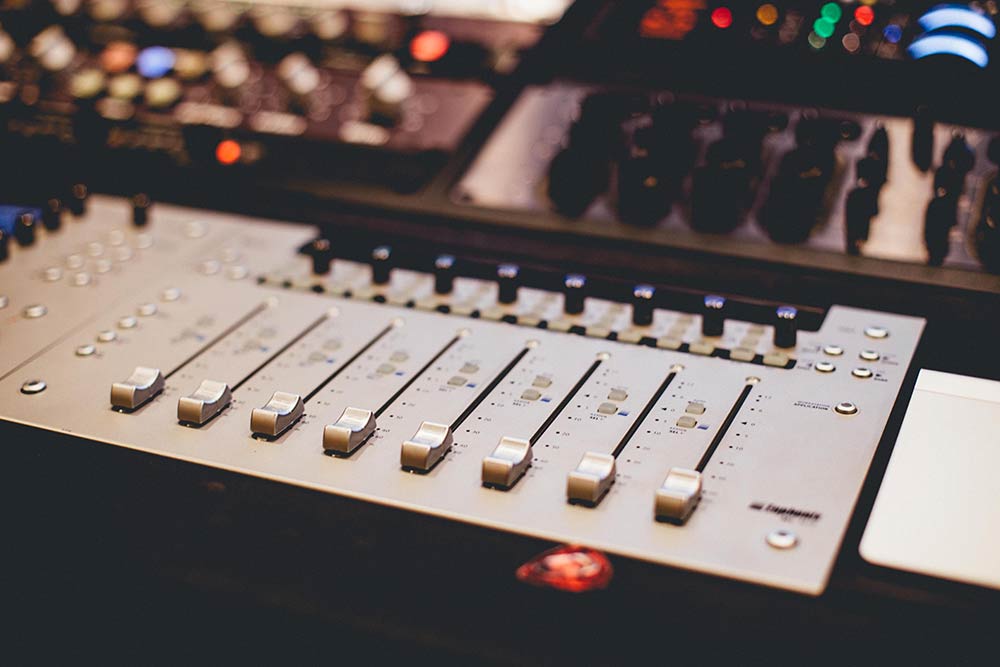
-
Table of Contents
- Introduction
- The Art of Sound Design: Techniques for Crafting Unique and Memorable Soundscapes
- How to Use Ambience and Background Sounds to Create a Sense of Place
- Tips for Mixing and Balancing Audio for Maximum Impact
- The Benefits of Using Music to Enhance Your Sound Design
- How to Use Foley and Sound Effects to Create an Epic Soundscape
- Conclusion
“Unlock the Power of Sound Design and Transform Your Film and Television Projects with Epic Soundscapes!”
Introduction
Creating epic soundscapes for film and television is an art form that requires a great deal of skill and creativity. It is the process of creating a unique sonic environment that helps to set the tone and atmosphere of a scene. It is a combination of sound effects, music, and dialogue that can be used to create a powerful and immersive experience for the viewer. In this article, we will discuss some tips for sound design in film and television, including how to create epic soundscapes. We will also discuss the importance of sound design in creating a successful film or television show. Finally, we will provide some resources for further exploration of sound design.
The Art of Sound Design: Techniques for Crafting Unique and Memorable Soundscapes
Sound design is an essential element of any audio production, from film and television to video games and podcasts. It is the art of creating and manipulating sound to create a unique and memorable soundscape. This article will explore the techniques used by sound designers to craft their soundscapes, from the basics of sound manipulation to more advanced techniques.
The first step in sound design is to understand the fundamentals of sound. This includes understanding the basics of sound waves, frequency, amplitude, and other aspects of sound. Once these fundamentals are understood, sound designers can begin to manipulate sound to create the desired effect. This can include adding effects such as reverb, delay, and distortion, as well as manipulating the pitch and volume of the sound.
In addition to manipulating sound, sound designers must also consider the context in which the sound will be used. This includes understanding the environment in which the sound will be heard, as well as the type of audience that will be listening. This will help the sound designer to create a soundscape that is appropriate for the context.
Once the soundscape has been created, sound designers must also consider how to mix and master the sound. This includes understanding the basics of mixing and mastering, as well as the use of equalization and compression. This will help to ensure that the sound is balanced and that the soundscape is cohesive.
Finally, sound designers must also consider how to use sound to create an emotional response. This includes understanding the basics of music theory, as well as the use of sound effects and sound design techniques to create tension, suspense, and other emotions.
By understanding the fundamentals of sound design and applying these techniques, sound designers can create unique and memorable soundscapes that will captivate their audience. With practice and dedication, sound designers can become masters of their craft and create soundscapes that will stand the test of time.
How to Use Ambience and Background Sounds to Create a Sense of Place
Creating a sense of place in a story is an important part of writing. Ambience and background sounds can be used to help create a vivid and immersive atmosphere for readers. By using these elements, authors can help readers to feel as if they are in the story, rather than just reading it.
The first step in using ambience and background sounds to create a sense of place is to consider the setting of the story. What kind of environment is the story taking place in? Is it a bustling city, a quiet forest, or a bustling marketplace? Once the setting is established, the author can begin to think about the types of sounds that would be present in that environment. For example, in a bustling city, the author might include the sound of traffic, people talking, and the occasional siren. In a quiet forest, the author might include the sound of birds chirping, the rustling of leaves, and the occasional animal call.
The next step is to consider how these sounds can be used to create a sense of place. For example, if the story is taking place in a bustling city, the author might use the sound of traffic to create a sense of urgency and tension. The sound of people talking could be used to create a sense of community and connection. The occasional siren could be used to create a sense of danger and suspense.
Finally, the author should consider how to use these sounds to create a sense of atmosphere. For example, if the story is taking place in a quiet forest, the author might use the sound of birds chirping to create a sense of peace and tranquility. The rustling of leaves could be used to create a sense of mystery and anticipation. The occasional animal call could be used to create a sense of danger and excitement.
By using ambience and background sounds to create a sense of place, authors can help readers to feel as if they are in the story, rather than just reading it. By carefully considering the setting and the types of sounds that would be present in that environment, authors can create a vivid and immersive atmosphere for readers.
Tips for Mixing and Balancing Audio for Maximum Impact
1. Start with a Clean Slate: Before you begin mixing and balancing audio, make sure that all of your tracks are properly edited and that any unwanted noise has been removed. This will help ensure that your mix is as clean and clear as possible.
2. Set Your Levels: Make sure that all of your tracks are at the same level before you begin mixing. This will help you avoid clipping and distortion, and will ensure that your mix is balanced.
3. Use EQ: Equalization is an important tool for mixing and balancing audio. Use EQ to shape the sound of each track and to make sure that all of the elements in your mix are working together.
4. Use Compression: Compression can help to even out the levels of your mix and make it sound more cohesive. Use it sparingly, however, as too much compression can make your mix sound flat and lifeless.
5. Use Reverb: Reverb can help to create a sense of space and depth in your mix. Use it to add atmosphere and to make your mix sound more natural.
6. Listen in Different Environments: Listen to your mix in different environments to make sure that it sounds good in all of them. This will help you identify any issues that may need to be addressed.
7. Take Breaks: Take breaks while mixing and balancing audio to give your ears a rest. This will help you to stay focused and to make sure that your mix is as good as it can be.
8. Get Feedback: Get feedback from other people to make sure that your mix is as effective as possible. This will help you identify any issues that you may have missed.
The Benefits of Using Music to Enhance Your Sound Design
Music has long been used to enhance sound design in a variety of ways. From film scores to soundtracks, music has the power to evoke emotion, create atmosphere, and add depth to a scene. In recent years, the use of music to enhance sound design has become increasingly popular, with many sound designers incorporating music into their work to create a more immersive experience.
The use of music to enhance sound design can be beneficial in a number of ways. Firstly, music can be used to create a sense of atmosphere and emotion. By carefully selecting the right music, sound designers can create a mood or feeling that will draw the audience into the scene. Music can also be used to add depth and texture to a scene, creating a more immersive experience. Music can also be used to add tension and suspense to a scene, creating a sense of anticipation and excitement.
In addition to creating atmosphere and emotion, music can also be used to add clarity and focus to a scene. By carefully selecting the right music, sound designers can draw attention to certain elements of a scene, making them stand out and creating a more powerful impact. Music can also be used to bridge the gap between different scenes, creating a smooth transition and helping to keep the audience engaged.
Finally, music can be used to add a sense of cohesion to a scene. By carefully selecting the right music, sound designers can create a unified soundscape that ties together all the elements of a scene. This can help to create a more immersive experience, as the audience is able to connect with the scene on a deeper level.
In conclusion, the use of music to enhance sound design can be extremely beneficial. By carefully selecting the right music, sound designers can create a more immersive experience, adding atmosphere, emotion, depth, and cohesion to a scene. Music can also be used to draw attention to certain elements of a scene, creating a more powerful impact. As such, the use of music to enhance sound design is an invaluable tool for sound designers.
How to Use Foley and Sound Effects to Create an Epic Soundscape
Creating an epic soundscape with Foley and sound effects is an art form that requires a great deal of skill and creativity. It involves the careful selection and placement of sound elements to create a unique and immersive experience for the listener. In this article, we will discuss the basics of using Foley and sound effects to create an epic soundscape.
The first step in creating an epic soundscape is to select the right sound elements. This includes selecting the right Foley and sound effects that will best convey the desired emotion and atmosphere. It is important to consider the context of the soundscape and the overall tone of the project. For example, a horror movie may require more intense and dramatic sound elements, while a romantic comedy may require more lighthearted and whimsical sound elements.
Once the sound elements have been selected, the next step is to place them in the soundscape. This involves carefully considering the placement of each sound element in relation to the other elements. It is important to consider the timing of each sound element and how it will interact with the other elements. For example, a sound effect may be placed at the beginning of a scene to set the tone, while a Foley element may be placed at the end of a scene to provide a sense of closure.
Finally, it is important to consider the overall mix of the soundscape. This involves balancing the levels of each sound element to ensure that the soundscape is cohesive and balanced. It is also important to consider the use of reverb and other effects to create a sense of depth and atmosphere.
By following these steps, it is possible to create an epic soundscape with Foley and sound effects. With careful selection and placement of sound elements, it is possible to create a unique and immersive experience for the listener.
Conclusion
Creating epic soundscapes for film and television is a complex and rewarding process. It requires a deep understanding of sound design principles, a creative approach to sound design, and a willingness to experiment and explore. By following the tips outlined in this article, you can create soundscapes that will bring your projects to life and captivate your audience. With the right tools and techniques, you can create soundscapes that will transport your viewers to another world.
